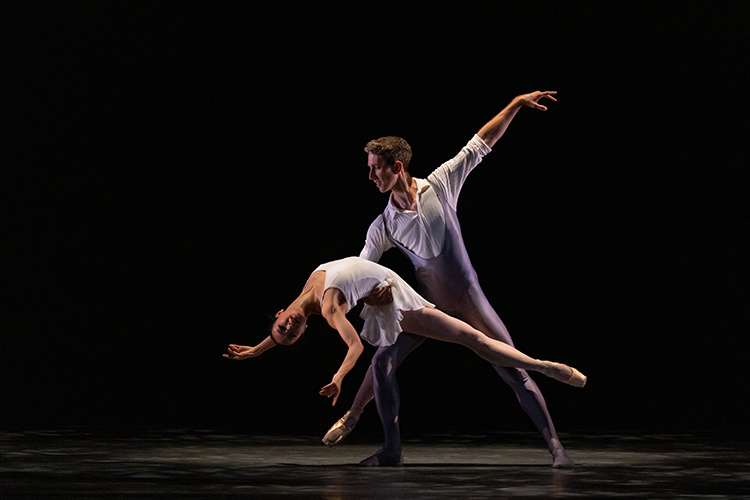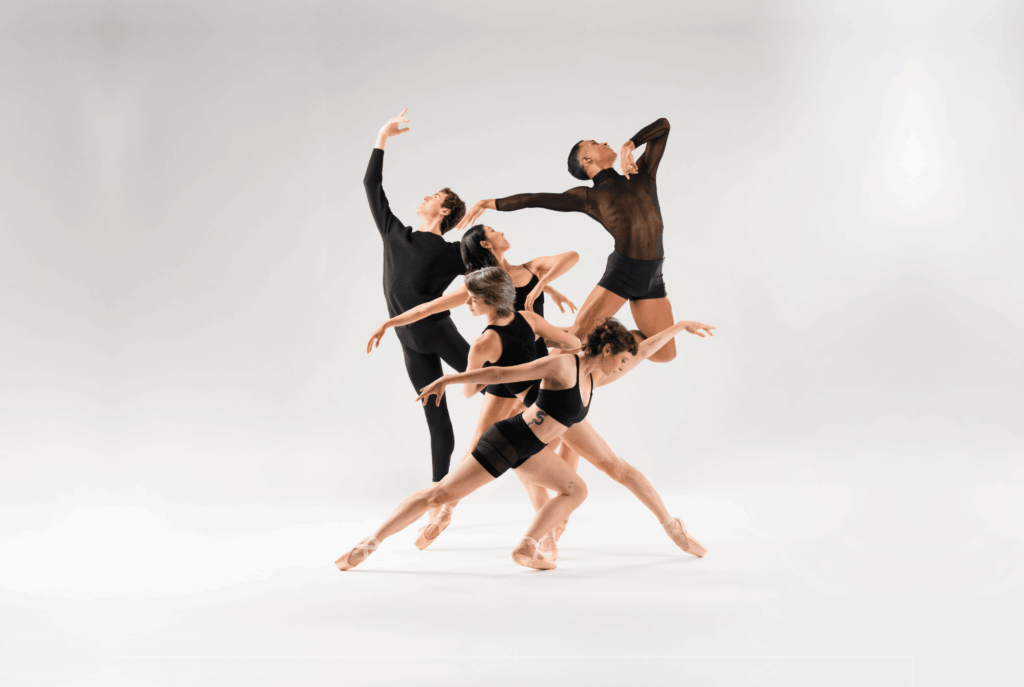
 “It was a gift to be able to create Wooden Dimes,” says the ballet’s choreographer, Oregon Ballet Theatre Artistic Director Dani Rowe. Originally planned as a stage production for San Francisco Ballet, she had to reimagine Wooden Dimes as a highly theatrical dance film in 2020 when pandemic-era restrictions upended SFB’s planned season. Now, at last, the piece is having its live-performance debut here in Portland—but the production that Rowe and the OBT dancers present today is more than simply a remake or a transposition of the ballet’s original choreography from screen to stage. Rowe has taken advantage of this opportunity to custom fit Wooden Dimes for the company of dancers she now leads, as well as for the audiences who will watch it unfold as she’d first envisioned it: in a proscenium theater, in real time. Interestingly but also inevitably, Rowe has discovered that the process of bringing this new iteration of her ballet to life has also brought out its many different facets, resonance, and meanings.
“It was a gift to be able to create Wooden Dimes,” says the ballet’s choreographer, Oregon Ballet Theatre Artistic Director Dani Rowe. Originally planned as a stage production for San Francisco Ballet, she had to reimagine Wooden Dimes as a highly theatrical dance film in 2020 when pandemic-era restrictions upended SFB’s planned season. Now, at last, the piece is having its live-performance debut here in Portland—but the production that Rowe and the OBT dancers present today is more than simply a remake or a transposition of the ballet’s original choreography from screen to stage. Rowe has taken advantage of this opportunity to custom fit Wooden Dimes for the company of dancers she now leads, as well as for the audiences who will watch it unfold as she’d first envisioned it: in a proscenium theater, in real time. Interestingly but also inevitably, Rowe has discovered that the process of bringing this new iteration of her ballet to life has also brought out its many different facets, resonance, and meanings.
When Rowe was commissioned to choreograph Wooden Dimes for SFB in 2021, one of the first things she did was tour the city’s Orpheum Theater, the venue where it was slated to be performed. “Whenever I make a ballet, I like to know where it’s going to be performed and how people are going to view it,” she explains. “As I walked through the Orpheum, which used to be a vaudeville theater, I thought it was so gorgeous and full of character that I wanted to build a story that could really live there.” Entranced by the history of the theater’s era, she developed a story that was set, appropriately, in the 1920’s, with the intention of choreographing a fun ballet about a woman’s journey to stardom. But when she had to pivot the project into a dance film, the difference in medium wasn’t the only part of her concept that shifted. The storyline became a little more personal. “As I was beginning to build the piece, maybe because of the pandemic, things came out that had to do with challenges I’ve had in my own life about certain decisions I’ve had to make. The conflict between career and family, when to stop dancing or whether to keep going, the relationships between those things that not just dancers but everybody can relate to,” Rowe says. “I also thought about my grandmother, who was a strong, career-driven woman who had to choose whether to give herself fully to that or to what society expected of her as a wife.”
The opportunity for a choreographer to amend or revise their work is never guaranteed, and indeed, Rowe says she would usually rather make a piece from scratch than tinker with a previous one. But she’s really relished the process of reconfiguring Wooden Dimes for the stage, and points out that in some ways, it’s a natural evolution for the ballet. “All the pieces I create are somewhat similar to film,” she says. “The way I view dance, the way I structure choreography, and the way I want audiences to see it all have to do with directing the viewer’s eye. Especially in a narrative, I’m thinking about how I can use cinematic elements like light and music to keep the story flowing and transform the atmosphere and mood as I’m building the piece. They’re not afterthoughts.”
Understandably, however, dance that was crafted specifically for the camera doesn’t necessarily have the same impact when placed on a stage and seen from a single, front-view angle. Rowe has entirely reworked some sections of the ballet with that in mind, but also to take advantage of the chance to edit. “The structure remains the same as far as the story is concerned, but there are parts that I’ve almost started from scratch, purely because I thought I could do better,” she says. A major revamp happened with a dressing room scene which Rowe says is fundamental to the ballet. “The director comes into Betty’s dressing room and showers her with adoration and validation. Her heart is bursting with feelings of being loved and accepted, which are the things a performer works so hard to receive from an audience, but really for many performers, it’s that one person who matters the most— a director, a producer. It’s a transformational moment for Betty that I wanted to build on.”
As she dug deeper into the ballet in rehearsals with the OBT dancers, Rowe says she saw more clearly how its themes of inner and interpersonal friction translate from how they are framed in the theatrical world of Wooden Dimes to the life of anyone, performer or not. “I think this is really a story about conflict and miscommunication,” she says. “Everyone has their own world within themselves, and can you ever really know or understand someone else’s? I think that for a lot of people watching the ballet, it will be about trying to figure your partner out. Trying to understand what’s making them operate in the way that they do, and whether you can live with that and love them for it, even if you might not completely understand it.”
Wooden Dimes is not the first ballet of Rowe’s that OBT has performed, but it is the first time the company is doing her work since she became the company’s artistic director. “I think we all, the dancers and myself, feel a certain level of pressure to do a great job,” Rowe says. “But along with that is this excitement and drive to create great work, and to do it together.” The difference between being a visiting guest choreographer and the organization’s artistic leader is a significant, and very welcome and appreciated, ingredient in this presentation of Wooden Dimes. Rowe describes how being in this position feels, and why it matters. “Being in the studio with these dancers in this capacity is such a joy,” she says. “I feel like now I can exhale. They are so invested, so curious, so generous with their offering… they finish my sentences choreographically. It’s a big part of why I wanted to take on this role and work intimately and consistently with a group of dancers. It’s really validating.”
By Gavin Larsen
Originally published in OBT’s Wooden Dimes playbill
Gavin Larsen is a former OBT principal dancer. She now teaches and writes about dance from Asheville, NC. Her memoir, Being a Ballerina: The Power and Perfection of a Dancing Life, was published in 2021.

